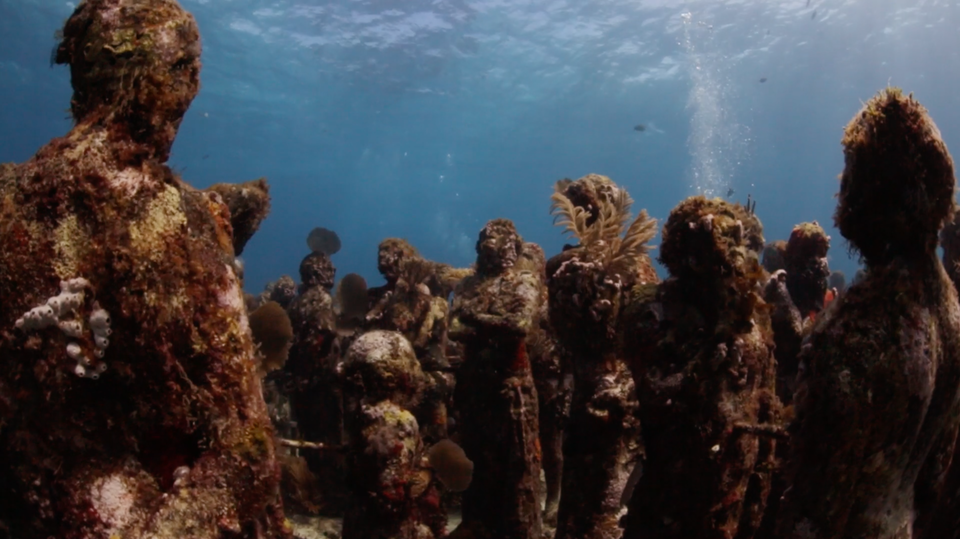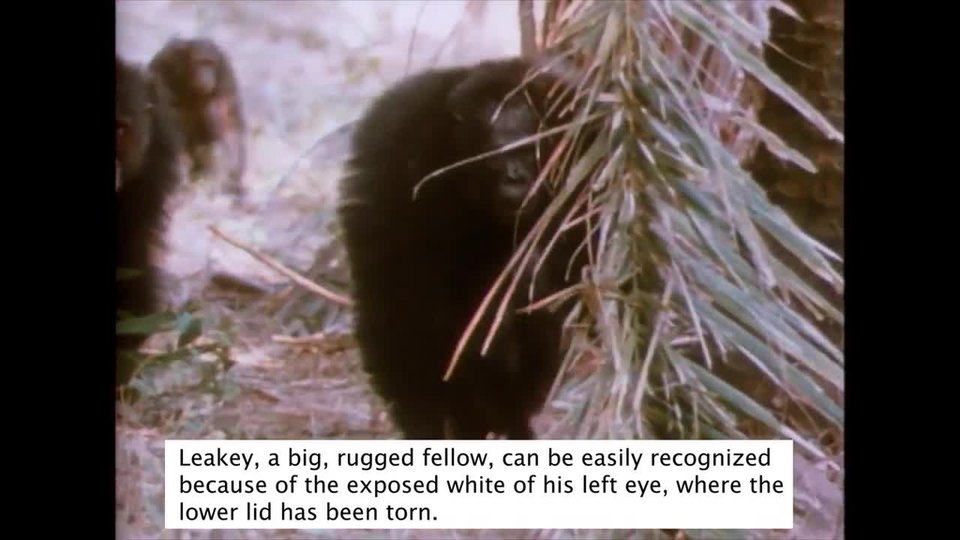GettingStarted
Toprotectnaturalreefs,wecanbuildnewreefs,artificialones.Artificialreefsmimic,orcopy,naturalones,buttheycanbecreatedfordifferentpurposes.Someartificialreefspreventcoastalerosion.Theyforcewavestodeposittheirenergyoffshoreratherthandirectlyonthecoastline.Otherartificialreefsaremeanttoholdsedimentonbeaches.Stillotherssimplyprovideahabitatforfishandotheraquatic life.
Tobuildanartificialreef,alargeobjectisusuallyinstalledinanareawheretheseabottomisflatandfeatureless.Whenoceancurrentsencounteralargeenoughobject,aplankton-richupswellingoccurs.Thatbecomesagoodspotforsmallfishtofeed.This,inturn,drawslargerfishtothe area.
Theobjectmayalsomakeagoodhidingplaceforhole-andcrevice-dwellerslikesnapper,eels,andtriggerfish.Overmonthsandyears,theobjectprovideshardsurfacestowhichalgaeandinvertebratessuchasbarnacles,corals,andoysterscanattach.Astimepasses,thecommunityofsealifeconnectedtotheobjectbecomesmoreandmorecomplexand diverse.
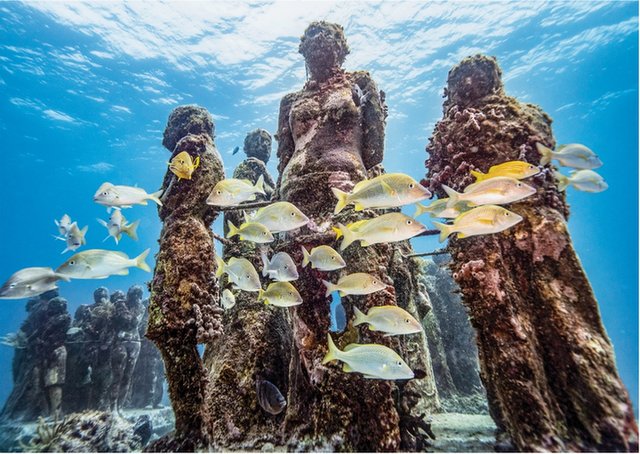
Thesestatueshavebeenunderwaterforseveralyears.Coralsandalgaegrowonthem.Fishswimamong them.
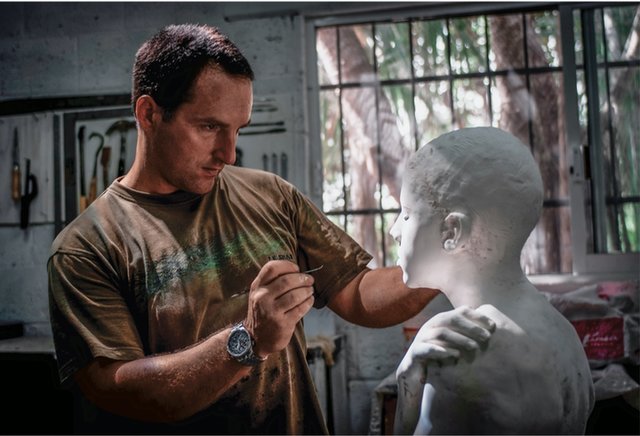
ArtistJasondeCairesTaylocarefullycraftsthefaceononeoftheunderwater statues.
SeedingSolutions
Creatinganartificialreeftakestime,andit’snotassimpleastossinganoldtireintotheoceanandwaitingforittosproutlife.MUSApresidentRobertoAbrahamsaysthatoneofthegreatestchallengestheyfacedincreatingtheunderwatermuseumsculptureswasusingtheright cement.
Ifthecementisn’tstrongenough,thestatuescrumbleovertime.Ifthesurfaceistooacidic,coralsandalgaecan’ttakeholdandgrow.OncetheMUSAstaffandartistsfoundtherightmix,theywereabletocreatethestatues.Then, theyhand-seededmanyofthestatues.Theyplacedyoungstaghorncoralpolypsonthesurfaceofthestatuestogivethegrowthaheadstart.Thetransformationisslowbutmiraculous.“Whenweplacethesesculpturesunderwatertheystartoutlikeablankcanvas,”Abrahamsays.“Butsoonnaturepaintsthemandprovidestextures.Theyevolveevery day.”
CoralsdecoratetheseMUSA statues.
RepurposingRigs
Artisn’ttheonlyarchitecturethatcanbeusedtomakeanartificialreef.Abandonedoilrigscanalsodoubleasreefs!Oilrigsareenormousstructuresbuiltindeepwater.Typically,theyarebuiltonthecontinentalshelf,whichismadeupofclay,mud,andsand.There,theydrillfor oil.
Whentheserigsarenolongerinuse,theRigstoReefsprogramturnsthemintodeep-seaartificialreefs.IntheUnitedStates,manyoftheGulfStatesparticipateinthisprogram.Todate,morethan500rigshavebeenconverted,mostlyinTexasandLouisiana.Therigscanbecutoffatthebaseandtippedover.Or,theycanbecutinhalfandthepiecesarrangedside-by-side.Therigcanevenbecutintopiecesandhauledtoadifferent location.
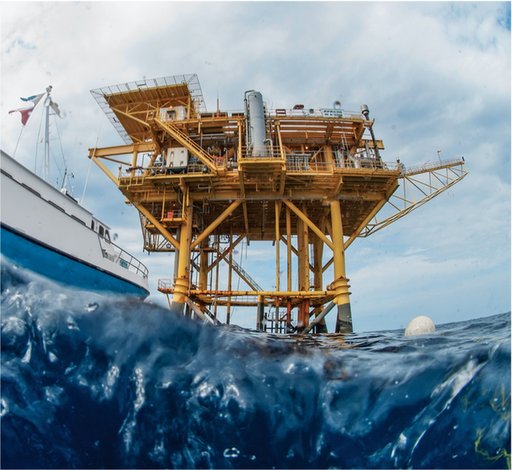
Thisrigmayonedaybecomepartofanartificial reef.

Surroundedbyfish,thesecoralsgrowonanartificial reef.
HelpingOutaGiant
Atypicalrigcanprovideahabitatforasmanyas14,000fish!Persquarefoot,therigscansupportmoremarinelifethannaturalreefsdo.Creaturescometotheserigsbecausethesteelisagoodsurfaceforcoralsandsponges.Redsnapper,hogfish,andbarracudasmaketherigstheir home.
Theserigsarehelpingreviveaspeciesthatwasonceseverelythreatened.Goliathgroupershavebeenprotectedsince1990butarestillvulnerable.Thesefishcangrowtomorethan2.4meters(8feet)longandcanweighalmost363kilograms(800 pounds).Inrecentyears,theyhavebeenmostabundantneardeep,artificialreefs.KeithMillewiththeFloridaFishandWildlifeConservationCommissionhasobservedthemonsomeofhisdives.Tohim,it’sfirst‑handevidencethattheartificialreefsaresupportingkey species.
